Explore Su Tong Pae Bridge: Mae Hong Son’s Bamboo Treasure
Nestled on the outskirts of Mae Hong Son City, the Su Tong Pae Bridge, often referred to as the Bridge of Faith and Success, stands as a testament to the harmonious blend of nature, culture, and community spirit. This hidden gem, stretching gracefully over rice paddies and a serene stream, offers not just a path, but a journey through the heart of Thai traditions.
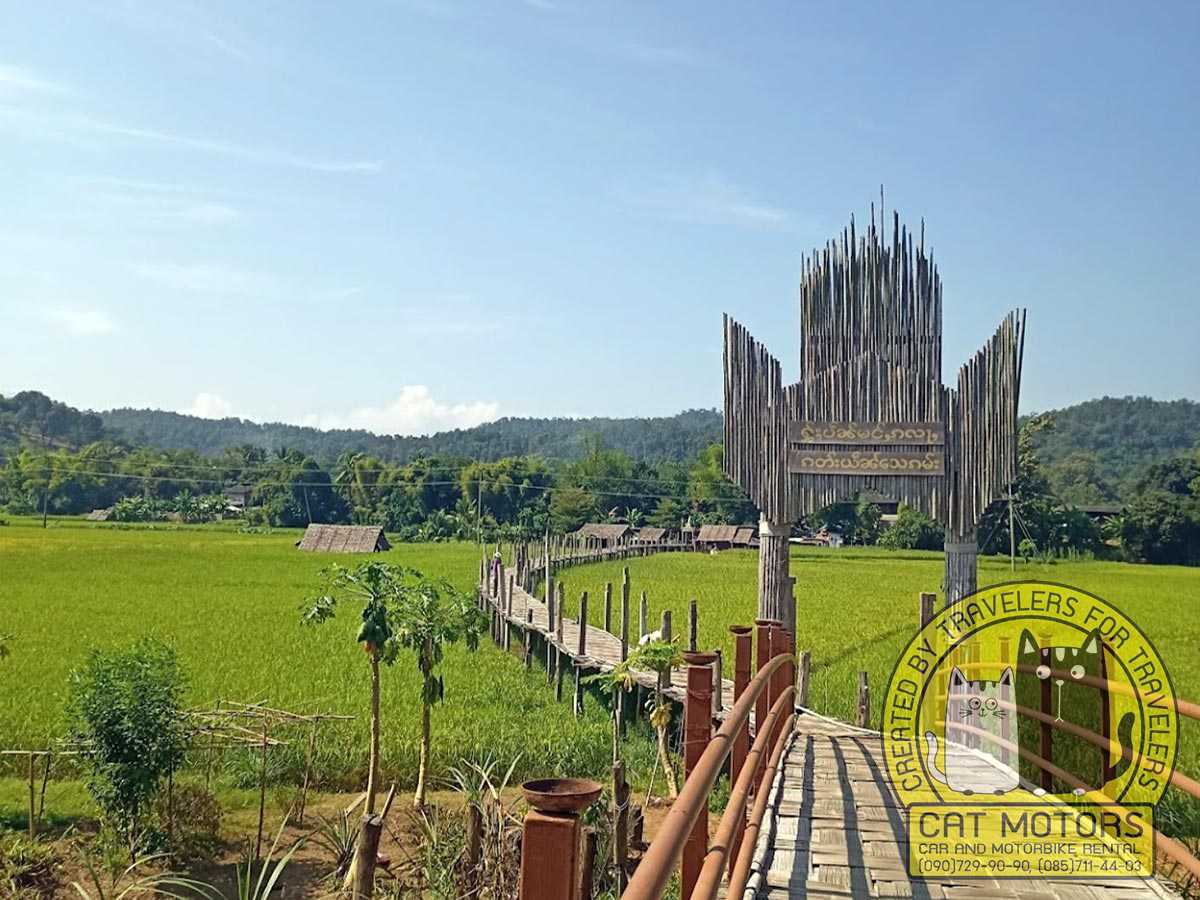
Constructed primarily of bamboo, the bridge’s name, “Su Tong Pae,” translates to “successful prayer” in the Tai Yai language. Its history is deeply rooted in community collaboration, with the land being generously donated by local farmers and the bridge itself being built by the villagers. It serves as a daily route for the monks of Wat Tham Poo Sa Ma, connecting them to the locals of Ban Gung Mai Sak.
The early morning mist that often envelops the bridge adds a mystical charm, making it a photographer’s dream and a traveler’s delight.
Getting There
Navigating your way to the Su Tong Pae Bridge (Google Map) is part of the adventure, offering glimpses of the picturesque Mae Hong Son landscape along the way.
By Road: If you’re driving from Mae Hon Son city, take Highway 1095. Approximately 10 kilometers from the town, keep an eye out on the left-hand side for a large sign indicating the Bamboo Bridge exit, which is 2km ahead. The roads are generally well-maintained, making for a smooth journey.
Public Transportation: While there isn’t a direct public bus to the bridge, you can take a bus to Mae Hong Son city and then hire a local tuk-tuk or taxi. It’s advisable to negotiate the fare beforehand.
Guided Tours: Several travel agencies in Chiang Mai and Mae Hon Son offer day trips to the bridge. These tours often include other attractions in the vicinity, providing a comprehensive experience.
Landmarks: As you approach the bridge, you’ll notice the tranquil rice paddies it spans across and the Wat Tham Poo Sa Ma temple, which it serves. These landmarks can guide you as you get closer.
Remember, the journey is as enriching as the destination. The route offers a chance to witness local life, lush landscapes, and occasionally, monks in saffron robes making their way to the bridge.
What to Expect
Stepping onto the Su Tong Pae Bridge is like entering a serene world where nature and spirituality converge. Here’s a glimpse of what awaits you:
The Bridge Itself: Made entirely of bamboo, the bridge boasts a rustic charm. It stretches impressively across rice paddies and a calm stream, offering panoramic views of the surrounding landscape. Its sturdy construction, despite the natural materials, is a testament to the craftsmanship of the local villagers.
Atmospheric Mornings: The early morning mist that blankets the bridge creates an ethereal ambiance. This is the perfect time for photography enthusiasts to capture the bridge in all its mystical glory.
Monastic Rituals: One of the unique experiences is watching monks from the nearby Wat Tham Poo Sa Ma temple walk across the bridge around 6:30 am, carrying alms bowls. Locals line up to offer food, flowers, and incense sticks, a ritual deeply embedded in Thai culture.
Local Beliefs: The bridge isn’t just a pathway; it’s a beacon of hope and faith. Locals believe that if you walk its length and make a wish, it will come true. Whether you’re spiritual or not, taking a moment to reflect and wish is a heartwarming experience.
Seasonal Changes: Depending on the time of year, the scenery around the bridge transforms. October sees lush green rice fields, while by December, after the harvest, the landscape takes on a golden hue.
Facilities: While the bridge retains its natural charm, there are some amenities for visitors. Sturdy wooden steps lead down to the bridge level. There are also vendors offering pretty umbrellas for rent, and cold water for sale, ensuring you stay refreshed during your visit.
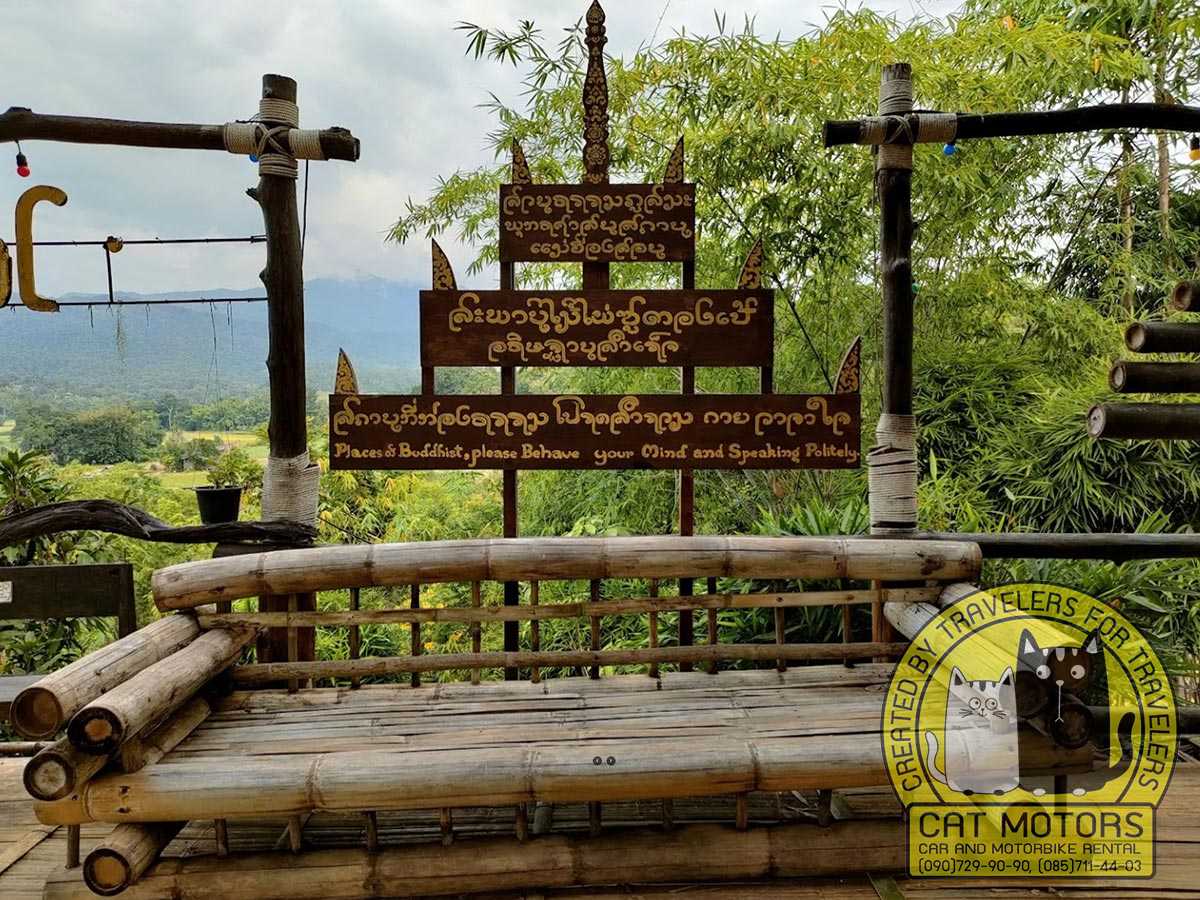
Visiting the Su Tong Pae Bridge is more than just a sightseeing excursion; it’s an immersive experience that offers a deep dive into the heart of Thai culture and traditions.
Cultural Significance
The Su Tong Pae Bridge is not just an architectural marvel but also a symbol of the region’s rich cultural tapestry.
Monastic Connection: The bridge serves as a vital link for the monks of Wat Tham Poo Sa Ma. Every morning, in a ritual that has been practiced for centuries, monks traverse the bridge to collect alms from the locals of Ban Gung Mai Sak. This daily procession, known as ‘Tak Bat’, is a beautiful blend of devotion, gratitude, and community spirit.
Name and Belief: The name “Su Tong Pae” holds deep spiritual significance. Translating to “successful prayer” in the Tai Yai language, it embodies the locals’ belief in the power of faith. Walking the bridge and making a wish is a cherished tradition, and many believe that sincere prayers made here come to fruition.
Community Collaboration: The bridge stands as a testament to the power of community. From the land donation by local farmers to its construction by villagers, every aspect of the bridge speaks of unity, cooperation, and shared purpose.
Seasonal Festivals: The area around the bridge comes alive during local festivals. One of the most enchanting sights is the Loy Krathong festival, where locals release decorated baskets into the water, creating a shimmering spectacle of light.
Language and Traditions: The Tai Yai language, spoken by many in the Mae Hong Son region, has influenced local customs, traditions, and even the name of the bridge. Engaging with locals offers insights into their unique way of life, influenced by neighboring Myanmar and the indigenous hill tribes.
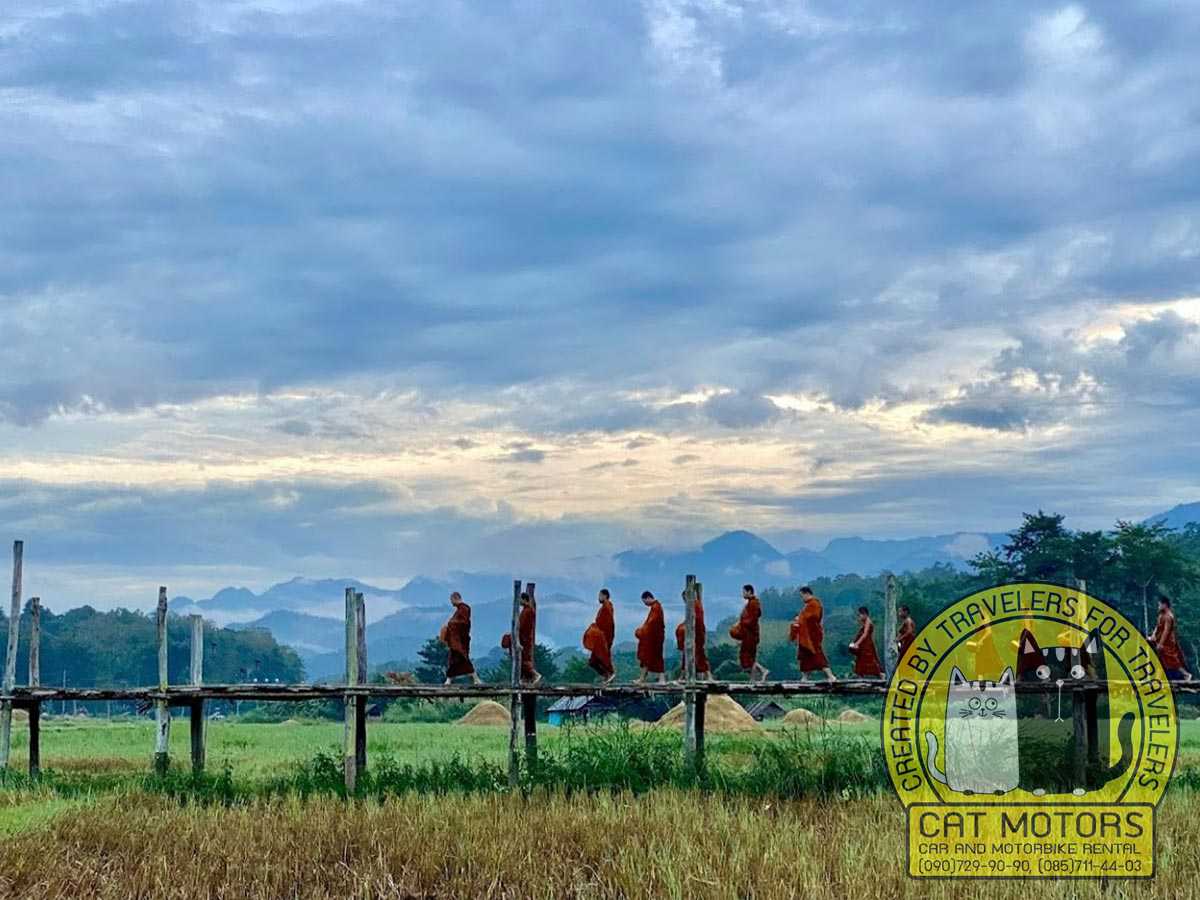
For a traveler, understanding the cultural significance of the Su Tong Pae Bridge enriches the experience manifold, turning a simple walk across a bamboo bridge into a journey through history, faith, and community spirit.
Activities and Attractions
Beyond the bridge itself, the surrounding area offers a plethora of activities and attractions that cater to a wide range of interests:
Bridge Walk: Naturally, the primary activity is a leisurely walk across the Su Tong Pae Bridge. Feel the bamboo beneath your feet, listen to the gentle rustling of the wind, and immerse yourself in the tranquil ambiance.
Monk Observance: Rise early to witness the monks’ morning alms collection ritual. This serene procession offers a genuine glimpse into Thai Buddhist practices.
Photography: The bridge, with its backdrop of rice paddies, flowing stream, and distant mountains, is a dream for photographers. The early morning mist adds an ethereal quality, perfect for capturing stunning shots.
Nearby Temples: Visit the Wat Tham Poo Sa Ma temple, which the bridge serves. Explore its architectural beauty and learn about its significance in the local community.
Local Markets: Experience the vibrant local culture by visiting nearby markets. Sample regional delicacies, purchase handcrafted souvenirs, and interact with friendly vendors.
Nature Walks: The lush surroundings offer opportunities for nature walks. Explore the verdant rice paddies, discover local flora and fauna, and enjoy the fresh air.
Culinary Adventures: Thai cuisine is renowned worldwide, and this region has its unique flavors. Try local dishes, from savory to sweet, and perhaps even join a cooking class.
Cultural Workshops: Engage in workshops that showcase local crafts, from bamboo weaving to pottery. It’s a hands-on way to appreciate the region’s artistic heritage.
Seasonal Events: Depending on when you visit, you might be fortunate to witness local festivals or events. These celebrations offer a deep dive into the region’s traditions and are often accompanied by music, dance, and feasting.
Exploring the activities and attractions around the Su Tong Pae Bridge ensures a holistic experience, blending nature, culture, and adventure.
Tips for Tourists
To ensure a memorable and respectful visit to the Su Tong Pae Bridge and its surroundings, here are some essential tips tailored for the discerning traveler:
Dress Appropriately: Given the bridge’s proximity to the Wat Tham Poo Sa Ma temple and its significance in local religious practices, it’s advisable to dress modestly. Wear clothing that covers your shoulders and knees, and remove your shoes when entering temple premises.
Interacting with Monks: When observing the monks during their morning alms collection, maintain a respectful distance. Women should avoid direct physical contact with monks.
Stay Hydrated: The tropical climate can be quite warm, especially during midday. Carry a bottle of water, and consider wearing a hat or using an umbrella for shade.
Local Etiquette: Thai people are known for their warm hospitality. A simple “wai” (a traditional Thai greeting involving a slight bow with palms pressed together) is a polite way to greet locals. Learning a few basic Thai phrases, such as “Sawadee” (Hello) and “Khob Khun” (Thank you), can enhance your interactions.
Safety First: While the bridge is sturdy, always be cautious, especially if it’s wet or crowded. Hold onto the railings and watch your step.
Support Local Businesses: Consider purchasing souvenirs, food, or services from local vendors. This not only provides an authentic experience but also supports the community.
Environmental Responsibility: Preserve the natural beauty of the area by avoiding littering. Carry a reusable water bottle and consider using eco-friendly products.
Stay Informed: Before your visit, check for any local events, festivals, or ceremonies that might affect access to the bridge or its surroundings.
Plan Ahead: While the bridge doesn’t have an entrance fee, always carry some cash for small purchases, donations, or transportation.
Respectful Photography: While the bridge and its surroundings offer fantastic photo opportunities, always seek permission before photographing individuals, especially during religious or cultural ceremonies.
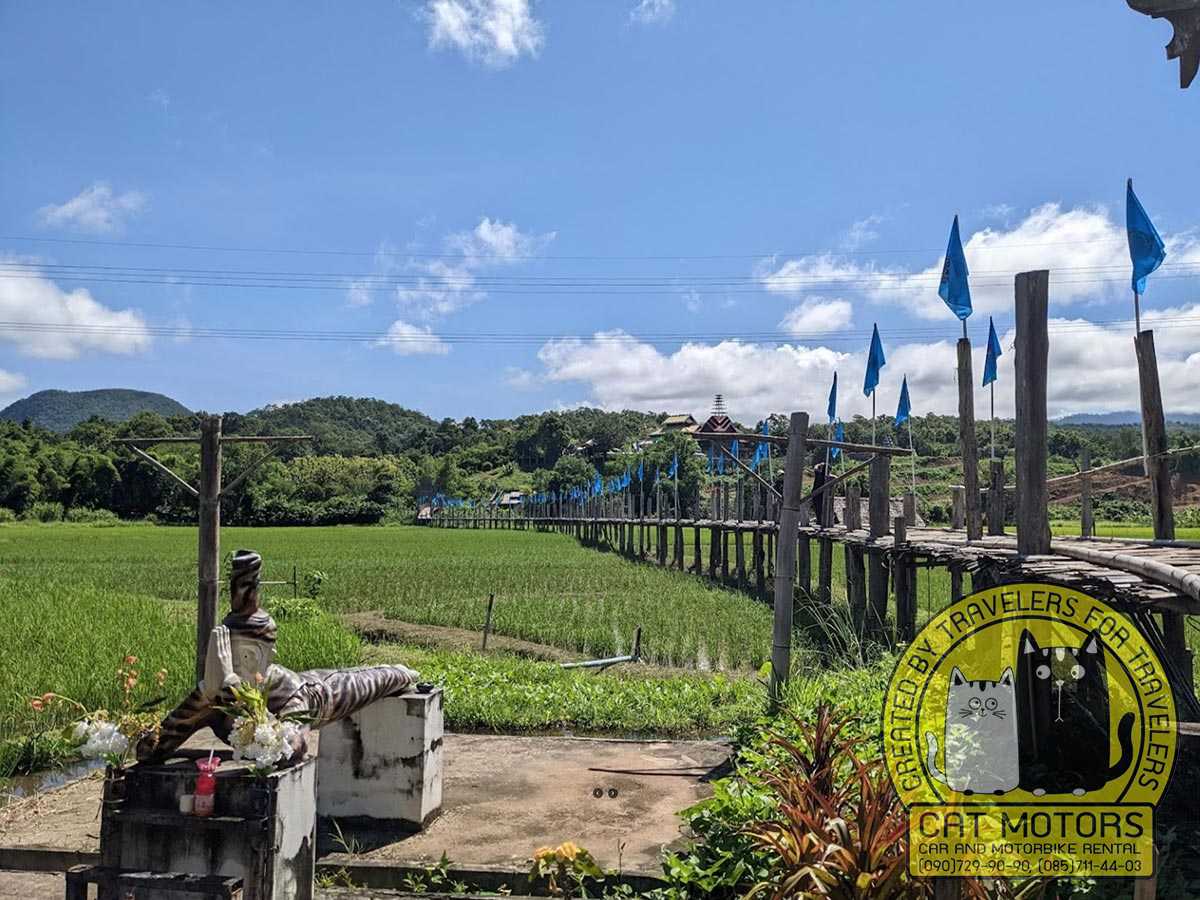
Equipped with these tips, tourists can navigate the Su Tong Pae Bridge and its environs with confidence, ensuring a visit that’s both enjoyable and culturally sensitive.
Local Cuisine and Dining
Mae Hong Son, the region where Su Tong Pae Bridge is located, boasts a culinary landscape influenced by its diverse ethnic groups and proximity to Myanmar. Here’s a guide to the gastronomic delights awaiting you:
Signature Dishes
- Khao Soi: A creamy coconut curry noodle soup, often served with chicken or beef. Topped with crispy noodles and accompanied by pickled mustard greens, lime, and shallots.
- Kanom Jeen Nam Ngeow: Rice noodles served with a spicy and tangy tomato-based soup, often with pork or chicken.
- Gaeng Hang Lay: A Burmese-influenced pork curry, slow-cooked with ginger, tamarind, and a mix of spices.
Street Food Delights
- Sai Oua: Northern Thai spicy sausage packed with herbs and flavors.
- Nam Prik Ong: A spicy tomato and minced pork dip, typically served with fresh vegetables or sticky rice.
- Miang Kham: A traditional snack made of betel leaves filled with a mix of shallots, peanuts, dried shrimp, lime, and more, topped with a sweet and salty sauce.
Beverages
- Cha Yen: Thai iced tea, a sweet and creamy drink made from tea, sugar, and condensed milk.
- Oliang: Thai iced coffee, often sweetened with condensed milk.
- Herbal Drinks: Local vendors might offer beverages made from herbs, flowers, or fruits unique to the region.
Sweet Treats
- Kanom Krok: Coconut rice pancakes that are crispy on the outside and soft on the inside.
- Sticky Rice with Mango: A classic Thai dessert, featuring glutinous rice sweetened with coconut milk, served alongside ripe mango.
Dining Options
- Local Markets: A visit to a local market offers a plethora of food stalls, where you can sample various dishes at affordable prices.
- Riverside Restaurants: Enjoy a meal with a view at eateries located along the riverbanks, offering both local and international cuisines.
- Street Vendors: Scattered around Mae Hong Son, these vendors offer authentic and fresh dishes, often cooked right in front of you.
- Vegetarian and Dietary Considerations: While Thai cuisine is predominantly meat-based, many eateries offer vegetarian or vegan versions of popular dishes. It’s advisable to specify your dietary preferences, as some dishes might contain fish sauce or shrimp paste.
Exploring the culinary offerings around Su Tong Pae Bridge is a feast for the senses, allowing travelers to savor the rich flavors and traditions of Northern Thailand.
Nearby Attractions
While the Su Tong Pae Bridge is a highlight, Mae Hong Son is brimming with attractions that showcase its natural beauty, cultural richness, and historical significance. Here are some must-visit spots:
Wat Phra That Doi Kong Mu: Perched atop a hill, this temple offers panoramic views of Mae Hong Son. The white chedis and the serene ambiance make it a peaceful retreat.
Pai: Just a few hours away, Pai is a laid-back town known for its hot springs, waterfalls, and bohemian vibe. The Pai Canyon and the Bamboo Bridge are among its top attractions.
Tham Pla – Pha Suea National Park: Home to the famous Fish Cave, this park is a haven for nature lovers. The cave is inhabited by carps, considered sacred by locals.
Mae Hong Son Living Museum: Delve into the region’s history, culture, and traditions at this museum. It offers insights into the lives of the Shan people and other hill tribes.
Night Market: Experience local life at Mae Hong Son’s night market. From handicrafts to street food, there’s plenty to explore and savor.
Mud Spa: Pamper yourself with a rejuvenating mud spa, a unique experience offered by several establishments in the region.
Trekking and Hill Tribe Visits: Engage in guided treks that take you through lush landscapes and introduce you to the hill tribes of Northern Thailand. It’s a chance to learn about their customs, traditions, and way of life.
Salween River: For the adventurous, consider a rafting trip on the Salween River, which forms the natural border between Thailand and Myanmar.
Burmese-style Temples: Mae Hong Son, due to its proximity to Myanmar, has several temples showcasing Burmese architectural influences. Wat Chong Kham and Wat Chong Klang are notable examples.
Hot Springs: Relax and rejuvenate in the region’s natural hot springs. The Pha Bong and Sai Ngam hot springs are popular choices.
When exploring Mae Hong Son, it’s advisable to respect local customs, especially when visiting religious or culturally significant sites. Always dress modestly and seek permission before photographing people.
With its diverse attractions, Mae Hong Son promises an enriching experience, blending adventure, relaxation, and cultural immersion.
Practical Information
To make the most of your visit to the Su Tong Pae Bridge and the surrounding areas, here’s some practical information to keep in mind:
Opening Hours: The bridge is open to visitors daily during daylight hours. However, if you wish to witness the monks’ morning alms collection, plan to arrive around 6:30 am.
Entrance Fee: There’s no admission fee to access the bridge. However, donations to support its maintenance and the nearby temple are always appreciated.
Facilities: Basic facilities, such as restrooms, are available near the bridge. Additionally, local vendors often sell refreshments and souvenirs.
Weather: Mae Hong Son has a tropical climate. The cool season (November to February) is the most popular time to visit, offering pleasant temperatures. The hot season (March to May) can be quite warm, so it’s advisable to visit early in the morning or late afternoon. The rainy season (June to October) sees fewer tourists, but the landscape is lush and green.
Accessibility: The bridge is not wheelchair accessible. Visitors should also be cautious during the rainy season as the bamboo can become slippery.
Local Contacts: It’s a good idea to have some local emergency contacts saved, including the nearest hospital, police station, and perhaps a local guide or tour operator.
Connectivity: While Mae Hong Son has decent mobile connectivity, it might be weaker in the more remote areas around the bridge. Consider downloading offline maps or any essential information.
Currency: Thailand uses the Thai Baht (THB). While major establishments in Mae Hong Son accept credit cards, it’s advisable to carry some cash, especially when visiting local markets or smaller eateries.
Language: Thai is the official language. However, English is understood in most tourist areas. Learning a few basic Thai phrases can enhance your interactions and is often appreciated by locals.
Health Precautions: Ensure you’re up-to-date with routine vaccines. Depending on your activities, consider vaccinations for Hepatitis A and Typhoid. Always drink bottled water and avoid consuming ice from unknown sources.
Being well-informed and prepared ensures a smooth and enjoyable experience, allowing you to focus on the beauty and cultural richness of the Su Tong Pae Bridge and Mae Hong Son.
Photography and Souvenirs
Capturing memories and taking a piece of Mae Hong Son back home is an integral part of the travel experience. Here’s a guide to immortalizing your visit and finding the perfect mementos:
Photography Tips
- Golden Hour: The early morning or late afternoon light provides a soft glow, perfect for capturing the bridge and its surroundings.
- Monk Procession: If you’re keen on photographing the monks during their alms collection, maintain a respectful distance and avoid using flash.
- Landscapes: Use a wide-angle lens to capture the expansive rice paddies and the bridge in its entirety.
- Details: The bridge’s bamboo structure, local flora, and even the patterns of local crafts can make for intriguing close-up shots.
- People: Always seek permission before photographing locals. Candid shots can capture the essence of daily life, but it’s essential to be respectful.
Souvenirs to Look Out For
- Handicrafts: Mae Hong Son is known for its unique crafts, from bamboo products to intricately woven textiles.
- Local Produce: Consider purchasing locally grown tea, coffee, or spices. They not only make for great gifts but also support local farmers.
- Art: Local artists often depict scenes from daily life, landscapes, or religious motifs. These artworks can be a beautiful reminder of your trip.
- Jewelry: The region is home to various hill tribes, each with its distinctive jewelry style. These pieces, often made of silver, are both decorative and symbolic.
Shopping Etiquette
- Bargaining: While it’s common to bargain in local markets, always do so politely and with a smile. Remember, the difference might be minimal for you but significant for the vendor.
- Supporting Local Artisans: Purchasing directly from artisans or community-run shops ensures that the proceeds benefit those who crafted the items.
- Eco-friendly Choices: Opt for products that are sustainably made and avoid items that might harm the environment or exploit wildlife.
- Responsible Souvenir Shopping: Avoid buying products made from endangered species or those that might have a negative impact on the environment or local communities.
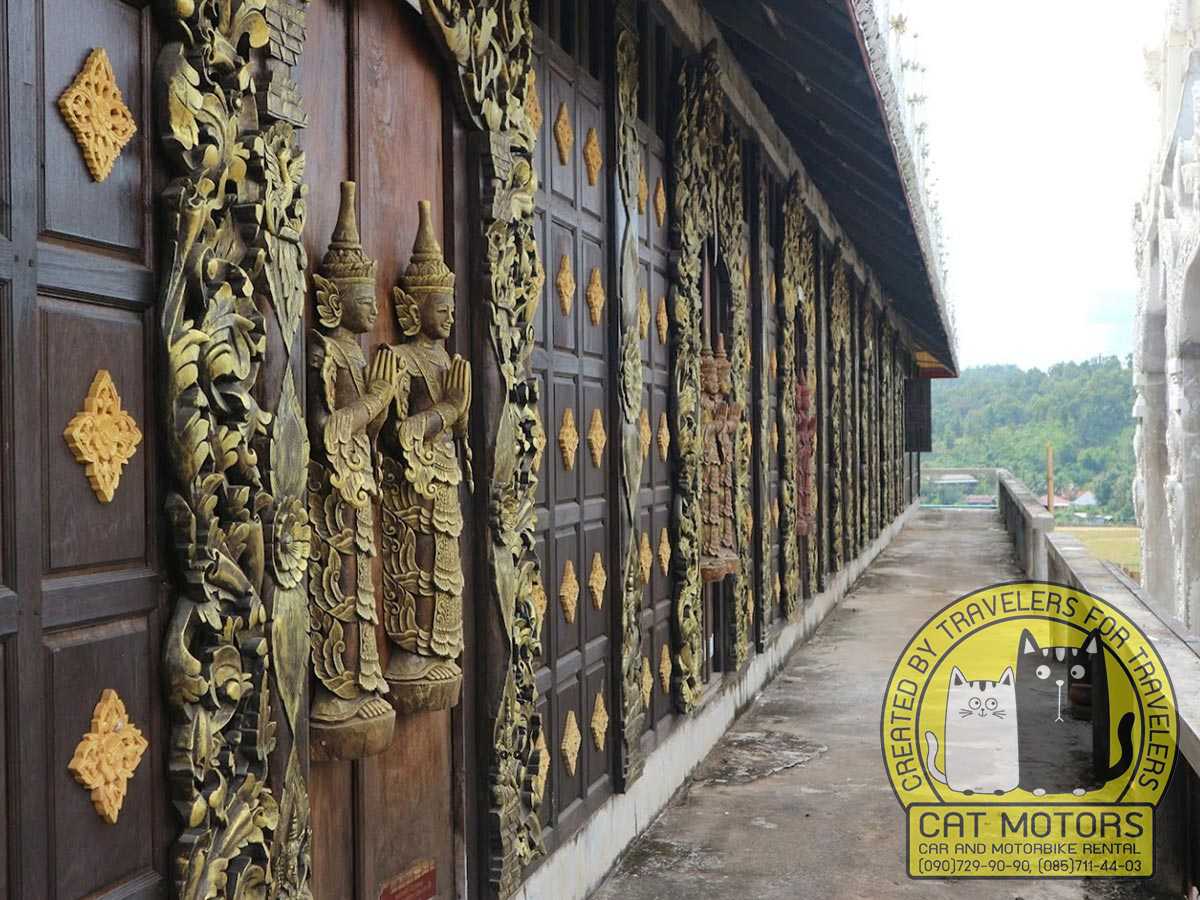
With these tips in hand, you can capture the essence of your journey and bring back souvenirs that hold special meaning, ensuring that the memories of the Su Tong Pae Bridge and Mae Hong Son linger long after your trip.
Final Thought
The Su Tong Pae Bridge, nestled in the heart of Mae Hong Son, is more than just a picturesque bamboo structure. It’s a living testament to the harmonious blend of nature, spirituality, and community. As you walk its length, you’re treading on stories of unity, faith, and local craftsmanship. Each step resonates with the morning chants of monks, the hopes of locals making wishes, and the whispers of the surrounding rice paddies.
Beyond the bridge, Mae Hong Son unfolds as a tapestry of rich traditions, culinary delights, and natural wonders. From the rhythmic rituals of monks collecting alms to the tantalizing flavors of Northern Thai cuisine, every experience is a deep dive into a culture that has been shaped by centuries of history and diverse influences.
But perhaps the most profound takeaway from a visit to this region is the sense of connection. Connection to a community that has preserved its traditions amidst modernity, to landscapes that evoke serenity, and to oneself. Amidst the rush of modern travel, the Su Tong Pae Bridge and its surroundings offer a rare pause, a moment to reflect, and an opportunity to truly connect with the essence of Northern Thailand.
In the end, while photographs and souvenirs might serve as tangible reminders of the journey, it’s these intangible connections and reflections that linger, making a trip to the Su Tong Pae Bridge not just a travel itinerary but a soulful pilgrimage.
FAQ
The Su Tong Pae Bridge is nestled in the Mae Hong Son province of Northern Thailand. It’s a serene spot just outside the town of Mae Hong Son, connecting the village of Kung Mai Sak to the Wat Tham Poo Sa Ma temple.
The bridge spans approximately 500 meters, making it one of the longest bamboo bridges in Thailand. It’s a leisurely walk, offering panoramic views of the surrounding rice paddies and hills.
No, there’s no admission fee to access the bridge. However, consider making a donation at the nearby temple, which goes towards the bridge’s maintenance and community initiatives.
Early morning, just after sunrise, is ideal. Not only can you witness the monks’ alms collection ritual, but the soft morning light also offers a magical ambiance. Late afternoon is another picturesque time, with fewer crowds.
Yes, the monks from the Wat Tham Poo Sa Ma temple walk the bridge daily during the early morning hours to collect alms from the local villagers. It’s a serene and culturally enriching experience.
While the bridge itself doesn’t have a strict dress code, it’s close to a temple. It’s respectful to wear modest clothing, covering shoulders and knees. If you plan to visit the temple, removing shoes is customary.
The bridge is sturdy and well-maintained. However, during the rainy season, the bamboo can become slippery. It’s advisable to tread carefully, hold onto the railings, and perhaps avoid visiting during heavy rain.
Yes, local guides can be hired in Mae Hong Son town. They offer insights into the bridge’s history, local customs, and the surrounding area, enriching your experience.
Mae Hong Son boasts a rich culinary landscape. Must-tries include Khao Soi (coconut curry noodle soup), Sai Oua (spicy sausage), and Kanom Jeen Nam Ngeow (rice noodles with spicy tomato soup).
While there aren’t many accommodations directly next to the bridge, Mae Hong Son town, a short drive away, offers a range of lodging options, from boutique hotels to guesthouses.
Mae Hong Son is brimming with attractions. Highlights include the Wat Phra That Doi Kong Mu temple, Pai town, Tham Pla – Pha Suea National Park, and the vibrant night market.
The Su Tong Pae Bridge is made of bamboo and doesn’t have ramps or handrails along its entire length, making it challenging for those with mobility issues.
Engage with local businesses, purchase handcrafted souvenirs, dine at local eateries, and consider donating to community projects or the temple. Your support directly benefits the residents and helps preserve the area’s cultural heritage.
Discover the wonders of Northern Thailand through our extensive travel guides, featuring the best scenic routes and local highlights. Begin your adventure by exploring our motorcycle rental in Chiang Mai. To ensure a smooth trip, review our terms and conditions thoroughly. With this preparation, you’ll be well-equipped to navigate mountain trails and quaint villages.
Our travel advice sections are filled with tips on how to stay safe and enjoy your journey. Learn about the best times to visit key attractions, participate in local festivals, and manage various road conditions. These insights will enhance your travel experience, making it both safe and enjoyable. Let us guide you through the stunning landscapes and vibrant culture of Northern Thailand, ensuring your trip is unforgettable.
UPD2: If you have any questions about your upcoming Mae Hong Son Loop journey, feel free to ask in the comments below.
- Author: Krit Sorenser
- Updated: 05/05/2025
- No Comments




